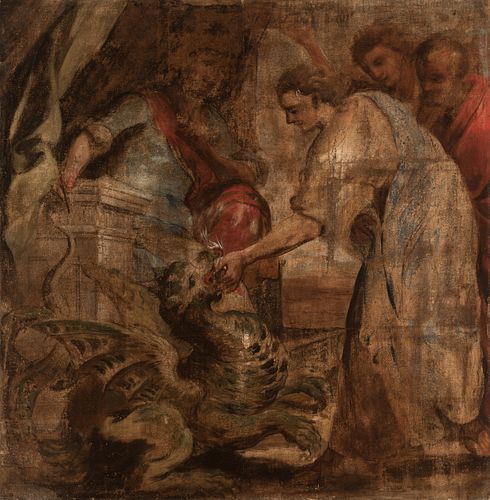Flemish school; 17th century. "Amisorades and the Chimera". Oil on serge.
Lot 43
About Seller
Setdart Auction House
Carrer Aragó 346
Barcelona
Spain
Setdart Subastas was born in 2004 and is currently the first online art auction in Spain with solidity, prestige and reliability guaranteed by our more than 60,000 users. Setdart has a young, dynamic and enterprising team ready to successfully manage the purchase and sale of art works through custom...Read more
Estimate:
EUR€7,000 - EUR€9,000
$7,526.88 - $9,677.42
Absentee vs Live bid
Two ways to bid:
- Leave a max absentee bid and the platform will bid on your behalf up to your maximum bid during the live auction.
- Bid live during the auction and your bids will be submitted real-time to the auctioneer.
Bid Increments
| Price | Bid Increment |
|---|---|
| EUR€0 | EUR€10 |
| EUR€200 | EUR€25 |
| EUR€500 | EUR€50 |
| EUR€1,000 | EUR€100 |
| EUR€3,000 | EUR€200 |
| EUR€5,000 | EUR€500 |
| EUR€10,000 | EUR€1,000 |
| EUR€20,000 | EUR€2,000 |
| EUR€50,000 | EUR€5,000 |
About Auction
By Setdart Auction House
Oct 20, 2021
Set Reminder
2021-10-20 07:30:00
2021-10-20 07:30:00
America/New_York
Bidsquare
Bidsquare : OLD MASTERS
https://www.bidsquare.com/auctions/setdart-auction-house/old-masters-7700
Setdart Auction House sofia@setdart.com
Setdart Auction House sofia@setdart.com
- Lot Description
Flemish school; 17th century. "Amisorades and the Chimera". Oil on serge. It presents damages and losses of the pictorial layer. Measures: 203 x 200 cm. Oil whose support, the serge, indicates us that it is very probable that it was a work conceived as cardboard for tapestry. In it a scene of mythological character is developed, where several characters swirl around a mythical animal. It has the head of a feline, wings, the body of a lion and the tail of a snake, so it is very likely that it is the representation of the Chimera. In the image, a woman feeds the animal while they are observed by two characters located in the right area of the composition, and a third man, seated on a throne. This indicates their preponderant social position with respect to the rest. Therefore, it is feasible that it is the king of Caria, Amisorades, who raised the Chimera, as if it were his pet, making it reside in Patara. However, the animal continued to terrorize the nearby cities, so King Yóbates asked Bellerophon to kill the animal. For its technical characteristics, this work can be related to the artistic production of the painter, Abraham van Diepenbeeck (Bolduque, 1596 - Antwerp 1675) was a scholar and multidisciplinary artist (painter, glass artist, draftsman and designer) of the seventeenth century. He trained in the art of stained glass with his father, in his native Bolduque, although by 1621 he moved to Antwerp, starting his career as a stained glass author (in fact, in 1622 he joined the Guild of St. Luke as a master glass painter). From this early period we find works of his hand as the stained glass windows of the cathedral of Antwerp with the acts of mercy or the life of St. Paul in the church of the Dominicans in the same city. However, only two years later, in 1623, he entered the workshop of Rubens. There he worked on mythological and historical themes, as well as portraits, showing a pictorial language of great skill and vigor and a colorful and vibrant palette. Diepenbeeck remained the rest of his life in Antwerp, obtaining citizenship in 1636 and being admitted to the Guild of St. Luke in the city just two years later (already as an easel painter). He played an important role in the pictorial scene of the time, and in fact in 1641 became director of the school that would become the Academy of Fine Arts of the city. We know that he later made a trip to Italy, as a result of which he began to make drawings, many of them transferred to engraving by Cornelis Bloemaert. In fact, his work as a draughtsman will take him to England for a while, where he will make illustrations for the book "General system of horsemanship in all its classes", in addition to portraying the first Duke of Newcastle and his family. Several sources indicate that Diepenbeeck was a prominent member of Rubens' workshop, especially important among his disciples. This claim is supported mainly by the fact that he was one of the painters who worked on the cartoons for "The Triumph of the Eucharist", the series of tapestries commissioned by Isabel Clara Eugenia for the Monasterio de las Descalzas in Madrid. Works by Abraham van Diepenbeeck are currently held in the Louvre Museum, the Hermitage of St. Petersburg, the Royal Collection and the Royal Academy of London, the Fitzwilliam of the University of Cambridge, the Fine Arts Museums of Antwerp, Lyon and Bordeaux, the Magnin of Dijon, the Episcopal of Haarlem, the National Gallery of Denmark and the Royal Museums of Belgium, among other outstanding collections.
- Shipping Info
-
In-house shipping available. Please inquire at admin@setdart.com.
-
- Buyer's Premium



 EUR
EUR CAD
CAD AUD
AUD GBP
GBP MXN
MXN HKD
HKD CNY
CNY MYR
MYR SEK
SEK SGD
SGD CHF
CHF THB
THB









